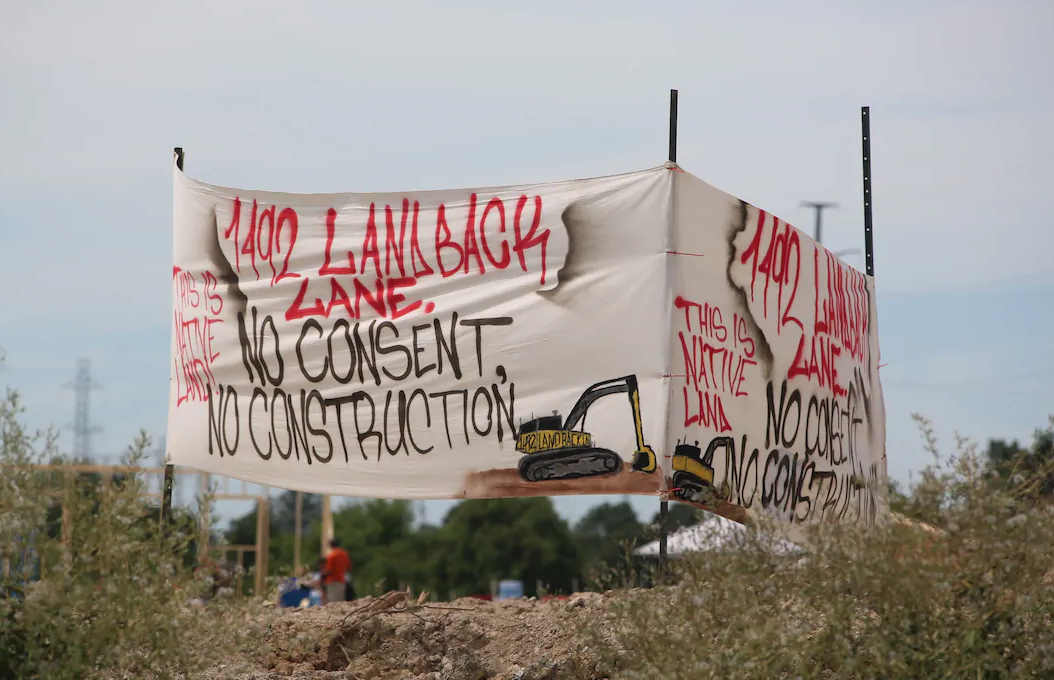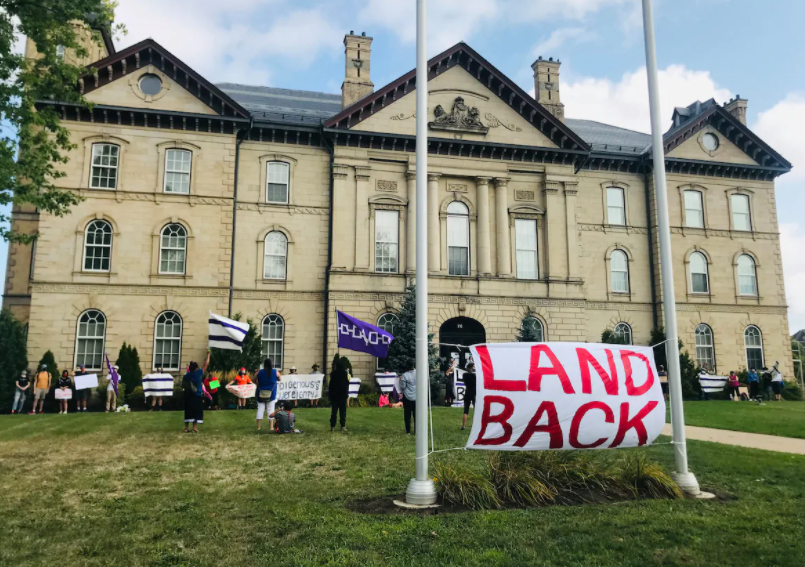
Haudenosaunee land defenders of the Six Nations of the Grand River reserve set up a reclamation camp, the 1492 Land Back Lane, in July of this year to stop the construction of a housing development on stolen land by Foxgate Development. After several injunctions ordering that the reclamation camp be removed, in late October the courts granted a permanent injunction against the reclamation camp. In a further attack, one of the reclamation camp land defenders has now been ordered to pay the legal bills of the developer and the municipality.
Stolen land
The 1492 Land Back Lane camp was set up to stop the development of McKenzie Meadows, a 218-unit subdivision being built by Foxgate Developments. Foxgate Developments paid $4 million for the 10 hectares of land bordering the town of Caledonia in 2015.
While the camp was set up in July, Beverley Jacobs, a Six Nations member and law professor, has explained that the roots of the conflict can be traced back some 250 years, to a time “before Canada became Canada”.
The Six Nations members of the reclamation camp have historical records showing that the land where the Foxgate subdivision is located was sold by a squatter to a settler who then received a land patent from the colonial authorities in 1853. This land was not obtained “legally”. It was stolen.
The land is covered under the 1701 Nanfan Treaty between the British and the Haudenosaunee Confederacy. The Nanfan Treaty granted the Haudenosaunee the right to harvest, hunt and fish through a large tract of land covering the midwestern U.S. and southern Ontario.
In addition, the McKenzie Meadows development is located within the Haldimand Tract. The Haldimand Tract was granted to the Six Nations of the Grand River in 1784 by the British Crown to compensate for lands lost and for allying with the British during the American Revolution. The land granted amounted to 10 kilometres on both sides of the 280-kilometre Grand River, running through southern Ontario and into Lake Erie.
Six Nations now has less than five per cent of its original lands. For 200 years, since the 1820s, the Haudenosaunee have repeatedly tried to safeguard the Haldimand Tract in the face of squatting and theft of lands.
Elected band council and traditional government
We have previously written about conflicts between elected band councils and the traditional Indigenous leadership. The Six Nations Elected Council (the band council) has signed an agreement with the developer for the project and supports the housing development, while the traditional leadership opposes the project and supports the reclamation movement. There is an inherent class divide here.
The band council has stated that, according to Ontario court decisions, there was no requirement or obligation for a private developer to accommodate Six Nations for developments on lands that were illegally taken in the 19th century. It should be noted that the council signed an agreement with Foxgate that transferred 17 hectares of land and $352,000 to Six Nations for accommodation. As in the case of pipelines, Foxgate, ignoring the traditional government, uses its agreement with the band council as “proof” of “sufficient consultation”.
Foxgate never consulted with the Haudenosaunee Confederacy Chiefs Council, the traditional Six Nations government. The Confederacy Chiefs Council has supported the 1492 Land Back Lane and asserts that the McKenzie Meadows development is located on land over which it claims title.
As reported in the Toronto Star:
The courts, Haldimand County’s local government and the developer do not recognize what the Haudenosaunee see as their well-documented claim to the Haldimand Tract, a 384,000-hectare ribbon of land, running the entire length of the Grand River, that was the subject of a 1784 treaty between the Haudenosaunee and the British Crown.
The land defenders and the Haudenosaunee’s traditional government, in turn, do not recognize what the court considers incontrovertible evidence of the developer’s title to the land, nor do they recognize the authority of the Six Nations’ Elected Council—which was imposed on the Haudenosaunee by the Indian Act—to make decisions on their behalf.
Even though the council has signed an agreement with the developer, it is interesting to note that the Six Nations Elected Council has an ongoing court case, filed in 1995, against Ottawa and Ontario over lost lands. It is scheduled to go to trial in 2022, almost 30 years after it was filed.
But even here there is an essential conflict between the band council and the traditional Confederacy Chiefs Council. If the claim is successful, it would only lead to monetary compensation, not a return of actual land. Haudenosaunee Confederacy Chiefs Council says the land is theirs and their consent is required for any development. The Confederacy Chiefs Council is not part of the band council’s land claim because for them it’s a question of land, not compensation.
The law and attacks on land defenders

Source: Kaley M. Reuben/1492 Land Back Lane/
Foxgate, Haldimand County, and the courts have thrown the book at the reclamation camp. The courts granted a temporary injunction against the reclamation camp in July, which has been extended numerous times. The Ontario Provincial Police (OPP) attacked the camp in early August to enforce this injunction and remove the camp. On Oct. 22 the courts made the injunction permanent and the camp was attacked again. While the OPP has attacked the camp several times and arrested 33 people since the occupation began, the camp still stands and the roadblocks have been expanded.
Superior Court Justice R.J. Harper has been only too happy to help the developers and the municipality, granting all their requests for injunctions and using the full extent of the law against the reclamation camp. He has attacked the reclamation camp members as “lawless protesters”.
Skyler Williams, one of the public faces of the camp, was declared in contempt of court for “open defiance”. Williams was thus punished for questioning the validity of the courts and for stating that he did not recognize the authority of colonial courts. Williams has also pointed out that the courthouse itself is on contested land.
Justice Harper then banned Williams from the court proceedings, and he was not allowed to be present when the permanent injunction was granted. Justice Harper has also struck all filings made by Williams to the court in his defence.
In an important move, Justice Harper has now declared Williams as the spokesperson or “leader” of the camp. Williams denies this is his role, explaining that the camp is a collective and makes its decisions democratically through meetings.
However, this has important legal ramifications. Justice Harper has ordered Williams, as the leader of the camp, to pay $168,000 to cover the legal fees of the developer and the municipality. The developer is also suing Williams for $20 million. The developer and the municipality are using the courts in an attempt to tie up the camp endlessly in the courts, to bleed it dry financially, with the ultimate aim of crushing the movement.
We have argued many times that the courts and the law cannot be relied upon by Indigenous peoples. The courts and the law are in fact used against Indigenous people, and historically have played a key role in the subjugation of Indigenous people and the theft of lands, etc. The subjugation and oppression of Indigenous people is written right into the law, and hence the very fabric of the country. You cannot dismantle the master’s house using the master’s tools, as the saying goes.
As an example, the Six Nations Elected Council filed 29 claims with regard to the Haldimand Tract between 1980 and 1995. Only one of the claims was ever resolved.
Yellowhead Institute, an Indigenous think tank at Ryerson University, conducted a national study of injunctions and First Nations people in Canada last year. As reported by the Toronto Star:
Researchers found that when First Nations people sought injunctions against corporations and governments, they were denied 81 and 82 per cent of the time, respectively. When corporations and governments sought injunctions against First Nations people, they were successful 81 and 90 per cent of the time, respectively.
The report itself says the following:
In plain terms, an injunction is a legal tool that restrains someone from doing something. Indigenous peoples and industry alike use injunctions to intervene in urgent matters. But injunctions are frequently used to override the lack of consent by Indigenous peoples to development on their lands. In Reconciliation Manifesto, Secwepemc leader Arthur Manuel called injunctions a ‘legal billy club’ because they are designed to move rightful title-holders off their land through force when they refuse to comply with decisions that deny their inherent rights.
The report adds:
When Indigenous people contest the authority of the province or the regulatory processes that fail to acknowledge their lack of consent, companies can take advantage of a legal system built to protect the interests of property. One legal mechanism in particular—the injunction—is often used to expedite the use of force against First Nations.
Courtney Skye, a Mohawk, Turtle Clan member of the Six Nations and a research fellow at the Yellowhead Institute, explained how the rule of law is “weaponized” against Indigenous peoples, telling the Toronto Star: “This is literally how Canadian law functions to steal land from Indigenous people. This is how land theft is made legal and the unfair mistreatment of Indigenous people is made legitimate in Canadian law. This is colonialism in action.”
Solidarity
The full extent of the law and the police are being used to clamp down on the 1492 Land Bank Lane reclamation camp. They are also throwing the book at the camp to scare anyone else from trying to do something similar now or in the future. The actions of the courts and the police in this sense are being used to issue a warning from the ruling class and governments, following the movement in solidarity with the Wet’suwet’en last year.
The labour movement and Indigenous organizations must issue a warning as well: we will no longer stand for this treatment of Indigeous peoples at the hands of the government and corporations, the courts, and the police. We will no longer stand for these attacks on Indigeneous rights.
The Ontario Federation of Labour (OFL) has released solidarity statements and along with the Canadian Union of Public Employees (CUPE) has organized solidarity demonstrations to support the struggle of the Haudenosaunee land defenders.
These types of actions are excellent first steps in the right direction. Mass demonstrations should be organized to bolster the camp and should be called in other cities to begin building the momentum of the movement. We must continue to work for the unity of all exploited classes and oppressed peoples in a common struggle against the root problems: capitalism, the ruling class and their state. We must work in common to build the united organizations that can overthrow this rotten system and put an end to the exploitation of working people and the centuries of oppression of Indigenous peoples.

